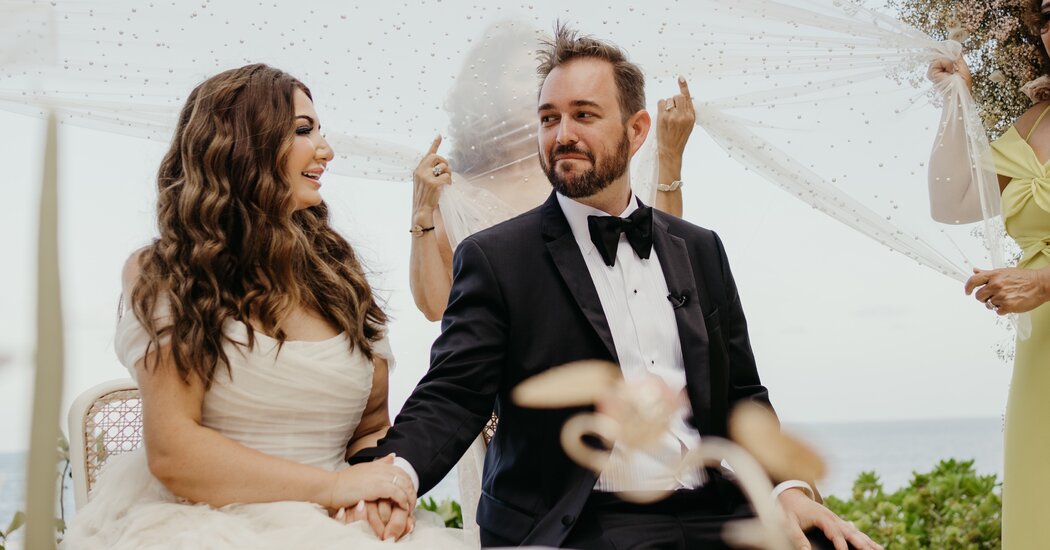
Weddings are steeped in tradition, but where do those rituals come from? “Traditions,” a new column, explores the origins of various wedding customs from around the world.
Ever since Mandana Ansari was a little girl, she knew she wanted to recognize her Iranian heritage by having a “Sofreh Aghd” on her wedding day. “I’ve always loved the symbolism and the meaning of the Sofreh — new life, new beginnings, fertility,” Ms. Ansari said. “My culture is such a huge part of who I am.”
The literal meaning of “Sofreh” is “traditional spread,” said Mitra Ghahramani, the creative director and founder of Designs by Mitra, an event and wedding planning company that specializes in Sofreh Aghd designs and multicultural ceremonies. The word “Aghd,” Ms. Ghahramani added, means “to connect, to tie together,” like a knot.
Mitra Ghahramani, who immigrated to the United States 26 years ago, comes from three generations of creative designers from Iran. At Designs by Mitra, she said, she is able to “actively engage with my heritage and contribute to preserving and promoting Persian traditions” that can be passed on to future generations.
Traditionally, Ms. Ghahramani said, the Sofreh Aghd refers to a large, white tablecloth that is placed on the floor to form a sacred space for the union. It is often adorned with elaborate linens featuring gold, silver, lace and silk embellishments.
“Sofreh Aghd refers to the traditional Persian wedding ceremony where the legal marriage typically takes place,” she said. “The couple sit in front of Sofreh adorned with symbolic items that are meant to bless the newlywed couple.”
The ritual often involves a bride and groom seated at the head of the Sofreh Aghd, a ceremonial table covered with items that have symbolic meanings, surrounded by family and friends.
The couple often face a large mirror and two lit candelabras, which represent their hopes for a promising future together. “The mirror is reflective of light and clarity of mind, and the fire symbolizes purity and energy representing a bright future for the newlyweds,” Ms. Ghahramani said. “During the ceremony, the newlyweds should see each other’s faces in the reflection of the mirror to ensure a bright future ahead.”
The spread features a plethora of symbolic items, such as honey and fruits, like pomegranates and apples, for a joyous future; nuts and gold coins for abundance; eggs to symbolize fertility; spices to ward off evil and to represent the spice of life; a needle and thread to denote two families becoming one; and a sacred book for faith, hope and God’s protection.
The origins of the Sofreh Aghd are unclear, but experts have some theories.
It “probably has Zoroastrian roots, but we only have descriptions of the ceremony starting in the 19th century,” said Willem Floor, the author of “Sofreh: The Art of Persian Celebration” and a Dutch historian who studies Persian culture. “It is quite likely that this tradition underwent changes since its inception as well as had regional variants.”
While Iranian weddings vary by ethnicity, culture and religion, some couples include Sofreh Aghds in their nuptials at the request of their parents, while others do so because they wish to connect with their heritage. For partners who come from different backgrounds, “there is a strong desire to share their culture and heritage with each other and their loved ones,” Ms. Ghahramani said.
As a Persian woman born in France and raised in San Francisco, Ms. Ansari, 38, knew she didn’t want a typical Sofreh Aghd. “I wanted to personalize it,” said Ms. Ansari. “A pastel, midcentury modern take — our ceremony was very much a hybrid of Western and Persian cultures.”
Ms. Ansari is a full-time content creator; the founder of Modern Girl Media, a marketing agency, and a founding member of the Iranian Diaspora collective, a nonprofit dedicated to amplifying the voices of Iranians.
On May 26, 2022, she married Brian Jensen at the New York City Clerk’s Office. Mr. Jensen, 38, is a native New Yorker and an Emmy-nominated filmmaker who worked on the HBO documentary “Welcome to Chechnya.”
The courthouse wedding was just a warm-up to honor the couple’s love affair with New York City. The main celebration took place in Cancún, Mexico, on June 26, 2022. That was when Ms. Ansari finally had the Sofreh Aghd she had long dreamed of.
She chose pieces for the spread that were designed by female artists, including a feathered mirror made in Spain. And instead of a Quran or Bible, she displayed a vintage book from 1786 filled with French love poems, including works by the Persian poets Rumi and Hafez.
“Since I’m Persian but was born in France, this felt most authentic,” Ms. Ansari said. “It’s our love and our union, so I want it to represent us.”
Sofreh Aghds often include several other wedding rituals like the Sugar Veil blessing ceremony, during which a lace cloth is draped over the bride and groom’s heads and two large sugar cones are slowly rubbed together, creating a haze of sugar dust to symbolize “sweetening” the couple’s life together. Married women usually conduct the ritual, but Ms. Ansari chose women she admired — including single women — instead.
“Tradition is that only women who are happily married can grind sugar over the newlyweds’ heads, so as to bless them with the wisdom and the fortune that they have gathered over the years,” Ms. Ghahramani said. “But more and more, I see modern twists to this tradition.”
Ultimately, the Sofreh Aghd should cultivate a supportive, harmonious atmosphere for the couple, Ms. Ghahramani said. “All elements of a Persian wedding ceremony are designed to foster an atmosphere of love, light, sweetness and happiness aiming to surround the couple with positive energy as they embark on their journey together,” she said. “That, to me, is the magic of this ceremony.”






